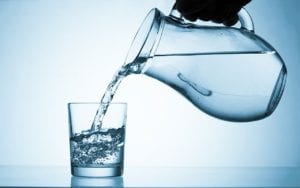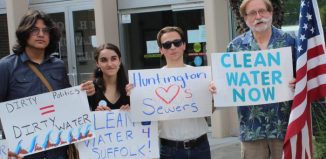By Nancy Marr
Water is a basic need and should be considered a right. In the Earth Day Legislative Package in June, the New York State Legislature included a proposed amendment to the New York State Constitution that would ensure that clean water and air are treated as fundamental rights for all New Yorkers. The bill prioritized keeping contamination like dangerous chemicals and pesticides out of our drinking water. Unfortunately, although it passed in the Assembly, it was not passed in the Senate.
All the water for Long Islanders comes from our three underground aquifers, including the water in our bays and harbors, lakes, ponds and streams. Experts tell us that some of the water in the uppermost aquifer is no longer safe to drink.
In the deeper aquifer (the Magothy), nitrogen and pesticides have increased by 200 percent between 1987 and 2005. Nitrogen pollution creates algal blooms in most of our bays, breeds weeds that choke lakes and ponds and threatens our fisheries and our recreation.
 The deepest and oldest of aquifers (the Lloyd) is small; water is being withdrawn from it, resulting in salt water intrusion in the Sound and Great South Bay. Although surface waters require nutrients, such as nitrogen, to support healthy ecosystems, excessive nitrogen can cause aquatic weed growth that draws oxygen from the water, producing “dead zones” where dissolved oxygen levels are so low that aquatic life cannot survive.
The deepest and oldest of aquifers (the Lloyd) is small; water is being withdrawn from it, resulting in salt water intrusion in the Sound and Great South Bay. Although surface waters require nutrients, such as nitrogen, to support healthy ecosystems, excessive nitrogen can cause aquatic weed growth that draws oxygen from the water, producing “dead zones” where dissolved oxygen levels are so low that aquatic life cannot survive.
To preserve its land, the five eastern towns (Southampton, East Hampton, Riverhead, Southold and Shelter Island) in 1998 created a community preservation fund, paid for by a 2 percent real estate transfer tax to purchase land to provide watershed protection through open space. (Recently, out of concern with nitrogen, referenda in the eastern towns have made it possible to use up to 20 percent for nitrogen removal.)
Nitrogen intrusion has been attributed to two factors: wastewater from cesspools and runoff from lawn and agricultural fertilizer. In 2017, County Executive Steve Bellone (D) introduced a Septic Improvement Program to replace existing cesspools and septic tanks with new systems that averaged an output of 9.2 mL of nitrogen, compared with systems that discharged anywhere from 40 to 120 mL in influent flows. To encourage homeowners to enroll in the program, the state, the county and Southampton and East Hampton offered grants and loans to cover the cost of the installation. The homeowner pays the maintenance.
The 2015-16 New York State budget appropriated funds to the Long Island Regional Planning Council (LIRPC) and the New York State Department of Environmental Conservation, in consultation with the Indian Nations, local governments and interested organizations, to create the Long Island Nitrogen Action Plan, or LINAP. Data, sorted by watershed, will make it possible to assess conditions and assist with prioritization. A project management team is responsible for LINAP administration and management, but local ownership and direction in its development is key.
In addition to public education, a bill to reduce the intrusion of discarded pharmaceuticals into the water supply through the Drug Take Back Act passed in both the Assembly and the Senate and was signed by Gov. Andrew Cuomo (D) in early July.
In April of 2018, Assemblyman Steve Englebright (D-Setauket) introduced a bill to prohibit the sale of any lawn fertilizer in Suffolk and Nassau counties with more than 12 percent nitrogen, with at least half of it water insoluble. It passed in the Assembly but when introduced in the Senate by Kemp Hannon (R-Garden City), it failed on the grounds that it is not certain that the nitrogen in the fertilizer is the major cause — that the 12 percent limit is arbitrary and unscientific.
Many local coalitions and organizations are involved in the campaign to keep our waters clean. They have lobbied and raised awareness. But even more action by Suffolk County voters is needed. On Nov. 6, voters will elect New York State Assembly and Senate members. If you are concerned about the quality of our water supply, let the candidates in your districts know that nitrogen intrusion is an important issue and urge them to support measures to remove it.
For more information, visit the websites of Citizens Campaign for the Environment, Long Island Pine Barrens Society, Group for the East End, Water for Long Island and the Nature Conservancy.
Nancy Marr is first vice president of the League of Women Voters of Suffolk County, a nonprofit, nonpartisan organization that encourages the informed and active participation of citizens in government and influences public policy through education and advocacy. For more information, visit www.lwv-suffolkcounty.org or call 631-862-6860.







